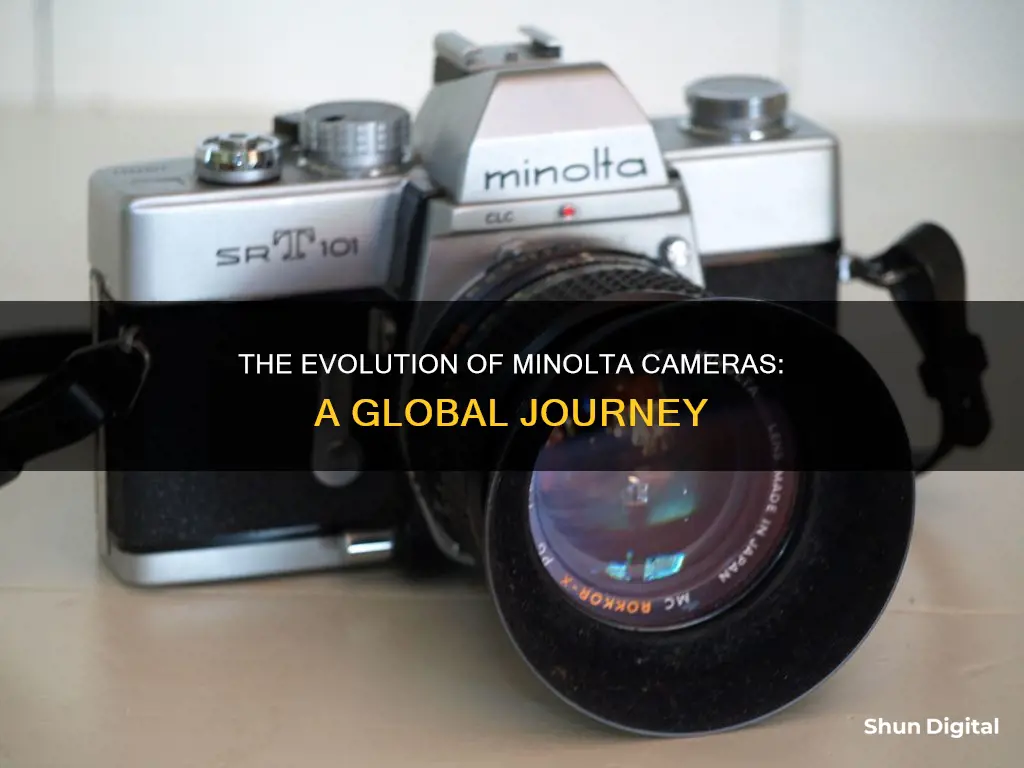
Minolta was a Japanese camera manufacturer that produced cameras from 1929 to 2003. The company was founded in Osaka, Japan, in 1928 as Nichi-Doku Shashinki Shoten, which means Japanese-German camera shop. In 1931, the company adopted the name Minolta, an acronym for Mechanism, Instruments, Optics, and Lenses by Tashima.
Minolta produced cameras for various film formats, including 16mm film, medium format, 35mm film, and more. They also produced other photography-related equipment such as scanners, movie cameras, and light meters.
In 2003, Minolta merged with Konica to form Konica Minolta, and in 2006, Konica Minolta sold its remaining camera interests to Sony, marking the end of Minolta's 75-year history as a camera manufacturer.
| Characteristics | Values |
|---|---|
| Founded | 11 November 1928 |
| Founder | Kazuo Tashima |
| Original name | Nichi-Doku Shashinki Shoten |
| Meaning of original name | Japanese-German camera shop |
| Acronym of final name | Mechanism, Instruments, Optics, and Lenses by Tashima |
| Founded in | Osaka, Japan |
| First camera produced | Nifcarette |
| Year first camera was produced | 1929 |
| Merged with Konica | 2003 |
| Sold remaining camera interests to Sony | 2006 |
What You'll Learn
- Minolta was a Japanese camera manufacturer from 1929 to 2003
- The company was founded in Osaka, Japan, in 1928
- Minolta merged with Konica in 2003 to form Konica Minolta
- Konica Minolta sold its remaining camera interests to Sony in 2006
- Minolta produced cameras for many film formats, from 16mm film to medium format

Minolta was a Japanese camera manufacturer from 1929 to 2003
Over the years, Minolta expanded its product offerings beyond cameras to include binoculars, photocopiers, fax machines, and laser printers. In 1958, Minolta introduced its first single-lens reflex (SLR) 35mm camera, the SR-2, which was equipped with a bayonet mount and instant return mirror. Minolta continued to innovate in the camera space, releasing the first integrated autofocus 35mm SLR camera system and the first commercially successful autofocus SLRs.
In 2003, Minolta merged with Konica to form Konica Minolta, and in 2006, the new company sold its remaining camera interests to Sony, marking the end of Minolta as a camera brand.
Unleashing Creative Control: Camera Raw Filter's Power
You may want to see also

The company was founded in Osaka, Japan, in 1928
Minolta Co., Ltd. was founded in Osaka, Japan, in 1928 as Nichi-Doku Shashinki Shoten (日独写真機商店), meaning Japanese-German camera shop. The company was founded by Kazuo Tashima, with support from German camera technicians Billy Neumann and Willy Heilemann. The first cameras used lenses and shutters imported from Germany.
In 1929, Minolta marketed its first camera, the "Nifcarette" (ニフカレッテ). In 1931, the company adopted its final name, an acronym for "Mechanism, Instruments, Optics, and Lenses by Tashima".
In 2003, Minolta merged with Konica to form Konica Minolta. In 2006, Konica Minolta announced that it was leaving the camera and photo business, and that it would sell a portion of its SLR camera business to Sony.
Minolta was a manufacturer of cameras, camera accessories, photocopiers, fax machines, and laser printers. The company produced cameras for many film formats, from 16mm film to medium format.
Minolta was a pioneer in the camera industry, being the first to introduce an autofocus SLR camera, the Maxxum 7000, in 1985. The company also created the first integrated autofocus 35mm SLR camera system.
In addition to its camera business, Minolta produced other photography-related equipment such as scanners, movie cameras, and light meters. The company also branched out into non-photography products, including fax machines and medical equipment.
Understanding Camera Raw: Unlocking the Luminance Power
You may want to see also

Minolta merged with Konica in 2003 to form Konica Minolta
Minolta Co., Ltd. was a Japanese manufacturer of cameras, camera accessories, photocopiers, fax machines, and laser printers. It was founded in Osaka, Japan, in 1928 as Nichi-Doku Shashinki Shoten (Japanese-German camera shop). In 1931, the company adopted its final name, an acronym for "Mechanism, Instruments, Optics, and Lenses by Tashima".
In 2003, Minolta merged with Konica to form Konica Minolta Holdings, Inc. The merger was a response to the crowded commercial battlefields dominated by rivals such as Canon, Ricoh, and Sony. The combined company aimed to increase sales and profit by leveraging the strengths of both brands. Konica was known for its expertise in film and lenses, while Minolta was renowned for its cameras and printers.
The integration of Konica and Minolta aimed to strengthen their position in Business Technologies, the core business of both companies. However, they also made the difficult decision to withdraw from the photographic film and camera business. The new entity, Konica Minolta, continued to operate in various segments, including business and industrial imaging, optical devices, medical and graphic imaging, sensing products, and textile printers.
The history of Konica Minolta dates back to the founding of its predecessor companies. Konica's origins can be traced to 1873 when Rokusaburo Sugiura began selling photographic materials. On the other hand, Minolta's founder, Kazuo Tashima, established the company in 1928, and they launched their first camera the following year. Both companies laid the groundwork for manufacturing independently developed products that offered new value to consumers.
The merger between Konica and Minolta officially took place in October 2003, with the corporate structure completing the reorganization during that time. The new entity, Konica Minolta, continued to operate and innovate in their respective fields, adapting to the changing landscape of technology and consumer needs.
Selfie Mode: Why Your Camera is Stuck and How to Fix It
You may want to see also

Konica Minolta sold its remaining camera interests to Sony in 2006
On January 19, 2006, Konica Minolta announced that it would be selling its remaining camera interests to Sony as part of its decision to leave the camera and photo business. This came after the company had already announced restructuring guidelines for its businesses in November 2005.
The decision to sell its camera interests to Sony was motivated by the need to reform its business structure in response to the shrinking traditional silver-halide photographic market due to the surge of worldwide digitization. Konica Minolta aimed to concentrate its business resources on non-consumer businesses, such as the "business technologies" field, the "optics and display devices" field, and the "medical imaging" and "sensing" fields.
As part of the agreement with Sony, Konica Minolta would transfer assets related to its digital SLR camera system, allowing Sony to develop digital SLR cameras compatible with the Maxxum/Dynax lens mount system. This would enable current Maxxum/Dynax users to continue using their lenses with Sony's digital SLR cameras. Konica Minolta would also consign its camera service operations for its branded cameras and related equipment to Sony.
The transfer of assets to Sony was completed on March 31, 2006, marking the end of Konica Minolta's 78-year history as a camera manufacturer.
Charging the Fujifilm FinePix 10 X Wide: A Step-by-Step Guide
You may want to see also

Minolta produced cameras for many film formats, from 16mm film to medium format
Minolta was a Japanese camera manufacturer that produced cameras from 1929 to 2003. The company was founded in Osaka, Japan, in 1928, as a Japanese-German camera shop. It was known for producing cameras for a variety of film formats, ranging from 16mm film to medium format.
In the 1950s, Minolta, then called Chiyoda, expanded beyond camera and binocular production into business services and photocopiers. Most of the company's endeavours were optics-related, including the copier and exposure meter branches.
Minolta's first camera, the Nifcarette, was released in 1929. In 1937, the company produced the Minolta Flex, Japan's second twin-lens reflex camera. The Minolta-35, introduced in 1947, was a long-lived 35mm rangefinder camera.
In the late 1950s and 1960s, Minolta competed in the medium-format roll-film camera market with the Autocord series of TLR cameras. The company also introduced its first single-lens reflex camera, the SR-2, in 1958.
Minolta continued to innovate in the camera space, releasing the first integrated autofocus 35mm SLR camera system and partnering with Leica to develop SLR cameras. The company eventually merged with Konica in 2003 to form Konica Minolta and sold its remaining camera interests to Sony in 2006.
The Craftsmanship Behind Leica Cameras
You may want to see also
Frequently asked questions
Minolta was a Japanese company that manufactured cameras from 1929 to 2003. It was founded in Osaka, Japan, in 1928 and had multiple plants in Japan, including Mukogawa, Amagasaki, Sakai, Komatsu, Itami, Nishinomiya, and Honsha.
Minolta produced cameras for many film formats, from 16mm film to medium format. They made rangefinder cameras, TLR cameras, 110 cameras, 126 cameras, and 35mm cameras. They also produced other photography equipment like scanners, movie cameras, and light meters.
Some of Minolta's notable cameras include the Minolta SR-2, the first 35mm SLR camera with a bayonet mount and instant return mirror; the Minolta SR-T 101, one of the world's best-selling cameras of its time; the Minolta XD-11, the first 35mm SLR camera with both aperture and shutter priority modes; and the Minolta Maxxum 7000, the first fully integrated autofocus SLR camera.
Minolta merged with Konica in 2003 to form Konica Minolta, and in 2006, Konica Minolta sold its camera business to Sony, ending a 78-year history as a camera manufacturer. Sony continued to develop DSLR cameras using Minolta technology until 2010.







